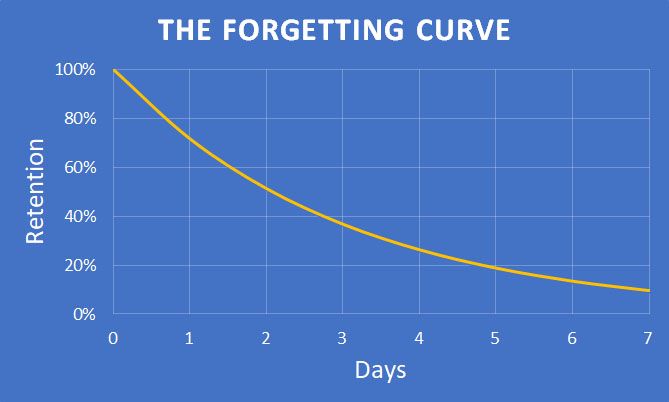This week, to round out this series on learning culture let’s take a look at some of the systemic components to learning culture that you’ll need to cultivate to find success.
I’m sure many of you have seen some aspect of the Forgetting Curve. It looks a little bit like the picture above.
It’s a fairly simple idea that everybody has experienced.
From the moment you learn a concept, you start forgetting it. The longer you are not exposed to a concept the more of the concept you forget.
The best way to combat the forgetting curve is to include these components into any learning plan you have:
- Content
- Cohort
- Practice and Reflection
- ROI
Content
In partnerships, it’s fairly common for learning content to be the exact same thing as marketing content. Which makes sense, because two birds with one stone.
The problem with marketing content as learning content is that marketing content is intended to persuade. For users who are bombarded with hundreds if not thousands of ad impressions everyday, marketing content feels untrustworthy. People know when they’re being sold.
Even though learning content has a similar purpose, in that it is trying to get the user to change their behavior, it is developed with trust as its primary intention. We want learners to change their behavior because we want them to grow, not because of what we are going to get out of it.
As partner program managers we know that ecosystems help sell more faster and create less churn, which is great for sellers. But our sales teams only see friction. By introducing content that works seamlessly into their workflow we can help them to change their behavior toward ecosystem selling. This is good for them, it’s good for the business, and it's good for our partners.
Cohorts
Having content that is built seamlessly into a seller’s workflow it isn’t enough.
Sellers need opportunities to communicate their understanding of the content. They need a place where open and honest feedback are not only an option, but encouraged.
Learning cohorts provide this opportunity.
Cohorts are small groups of peers that are in community with one another with the sole purpose of reflection and feedback.
Introducing a new behavior to a group of people who are grinding day in and day out is a big challenge. When they try out this new behavior of introducing a partner it’s probably going to expose all kinds of chinks in the metaphorical sales armor that will make your sellers feel deeply uncomfortable. It’s possible that it’ll introduce more friction than they feel it’s worth.
But these failures are a necessary function of building out a highly effective ecosystem. If you’re building out cross-functional cohorts that include individuals from partnerships, sales, product, and marketing and give them the freedom to share their failures and frustrations they’ll be able to reflect on how they applied your learning content.
They get to try out partnership selling in community. They’re not in a silo. They can be supported in failure and recognized in success.
These atomic partnership networks that are built internally as cross-functional cohorts can leverage network effects as the individuals inside of them become more and more successful, and the partnership program will start to see an uptick in partner engagement.
Practice and Reflection
The combination of just-in-time enablement content and an effective cross-functional cohort program are the practical components of any good learning culture.
But practice and reflection are what build experts.
Practicing an ecosystem sales motion can be really scary, particularly when sales teams rely on closing deals fast to do little things, like feed their families. Partner teams must do all they can to reduce this fear.
From a leadership perspective, there must be a tolerance for failure when experimenting with what this will look like in your organization. Leadership only tolerates failure when it’s done on a micro level.
So start small. Have one co-hort. Build your concise enablement content. Deliver it just-in-time and fit it into the already existing sales workflows, and then ask for feedback. Practice and Reflection in this atomic network should allow both the partner program and the sales team to iterate, and get better, and then demonstrate ROI.
ROI
Ah, the ever present ROI struggle of partnerships.
The good news is, with the rise of innovations in partner tech and this model of Content, Cohort, Practice, and Reflection it is easier than ever to define partner attribution.
ROI is linked to KPIing the building of learning culture. Build KPIs around Partner Enablement Content engagement. Build KPIs around cohort participation. Build KPIs around AE to partner AE reach out. Build KPIs partner program engagement feedback.
Building ROI starts small. Don’t try to boil the ocean. Choose a partner motion. I think starting with tech partnerships is probably the way to go. Define the KPIs around tech partner engagement, and learning. Build out internal partner learning content. Build a small cross-functional cohort, and then just start learning. ROI will follow close behind.
Building a learning culture in a company isn’t easy. It requires executive buy in and demonstrable ROI. But in difficulty is often opportunity. Building a learning culture through the ecosystem couldn’t be a better pairing.
Companies know they need partnerships. You have the opportunity to show them why.
Jessie Shipman is the CEO and Co-Founder of Fluincy, a Sales Enablement Software for Partnerships. She has a background in education and learning theory and spent 4 years building and delivering partner enablement strategy for Apple's top partnerships before building Fluincy.



